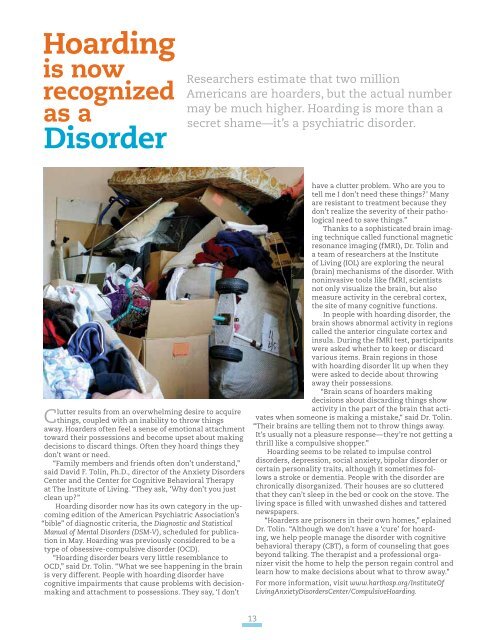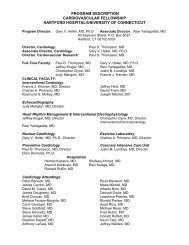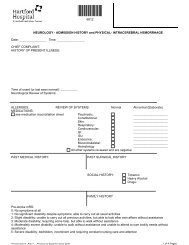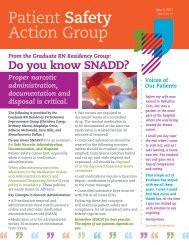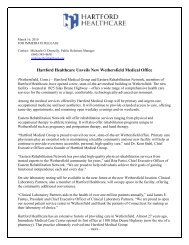Spring, 2013 - Hartford Hospital!
Spring, 2013 - Hartford Hospital!
Spring, 2013 - Hartford Hospital!
Create successful ePaper yourself
Turn your PDF publications into a flip-book with our unique Google optimized e-Paper software.
Hoarding<br />
is now<br />
recognized<br />
as a<br />
Disorder<br />
Researchers estimate that two million<br />
Americans are hoarders, but the actual number<br />
may be much higher. Hoarding is more than a<br />
secret shame—it’s a psychiatric disorder.<br />
Clutter results from an overwhelming desire to acquire<br />
things, coupled with an inability to throw things<br />
away. Hoarders often feel a sense of emotional attachment<br />
toward their possessions and become upset about making<br />
decisions to discard things. Often they hoard things they<br />
don’t want or need.<br />
“Family members and friends often don’t understand,”<br />
said David F. Tolin, Ph.D., director of the Anxiety Disorders<br />
Center and the Center for Cognitive Behavioral Therapy<br />
at The Institute of Living. “They ask, ‘Why don’t you just<br />
clean up?”<br />
Hoarding disorder now has its own category in the upcoming<br />
edition of the American Psychiatric Association’s<br />
“bible” of diagnostic criteria, the Diagnostic and Statistical<br />
Manual of Mental Disorders (DSM-V), scheduled for publication<br />
in May. Hoarding was previously considered to be a<br />
type of obsessive-compulsive disorder (OCD).<br />
“Hoarding disorder bears very little resemblance to<br />
OCD,” said Dr. Tolin. “What we see happening in the brain<br />
is very different. People with hoarding disorder have<br />
cognitive impairments that cause problems with decisionmaking<br />
and attachment to possessions. They say, ‘I don’t<br />
have a clutter problem. Who are you to<br />
tell me I don’t need these things?’ Many<br />
are resistant to treatment because they<br />
don’t realize the severity of their pathological<br />
need to save things.”<br />
Thanks to a sophisticated brain imaging<br />
technique called functional magnetic<br />
resonance imaging (fMRI), Dr. Tolin and<br />
a team of researchers at the Institute<br />
of Living (IOL) are exploring the neural<br />
(brain) mechanisms of the disorder. With<br />
noninvasive tools like fMRI, scientists<br />
not only visualize the brain, but also<br />
measure activity in the cerebral cortex,<br />
the site of many cognitive functions.<br />
In people with hoarding disorder, the<br />
brain shows abnormal activity in regions<br />
called the anterior cingulate cortex and<br />
insula. During the fMRI test, participants<br />
were asked whether to keep or discard<br />
various items. Brain regions in those<br />
with hoarding disorder lit up when they<br />
were asked to decide about throwing<br />
away their possessions.<br />
“Brain scans of hoarders making<br />
decisions about discarding things show<br />
activity in the part of the brain that activates<br />
when someone is making a mistake,“ said Dr. Tolin.<br />
“Their brains are telling them not to throw things away.<br />
It’s usually not a pleasure response—they’re not getting a<br />
thrill like a compulsive shopper.”<br />
Hoarding seems to be related to impulse control<br />
disorders, depression, social anxiety, bipolar disorder or<br />
certain personality traits, although it sometimes follows<br />
a stroke or dementia. People with the disorder are<br />
chronically disorganized. Their houses are so cluttered<br />
that they can’t sleep in the bed or cook on the stove. The<br />
living space is filled with unwashed dishes and tattered<br />
newspapers.<br />
“Hoarders are prisoners in their own homes,” eplained<br />
Dr. Tolin. “Although we don’t have a ‘cure’ for hoarding,<br />
we help people manage the disorder with cognitive<br />
behavioral therapy (CBT), a form of counseling that goes<br />
beyond talking. The therapist and a professional organizer<br />
visit the home to help the person regain control and<br />
learn how to make decisions about what to throw away.”<br />
For more information, visit www.harthosp.org/InstituteOf<br />
LivingAnxietyDisordersCenter/CompulsiveHoarding.<br />
13


